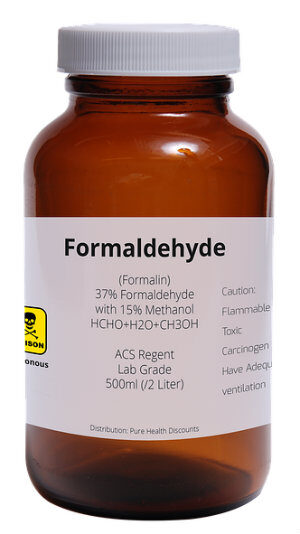What are VOCs?
VOCs, or volatile organic compounds, are a family of chemicals that readily evaporate and turn into gases and vapour. Put simply, this means they give off odorous fumes and increase the concentration of potentially harmful chemicals in the air.
And in the modern age, they can be found everywhere. From the pungent smell of fresh paint to household air fresheners, perfumes and nail polishes, thousands of these chemicals are encountered on a daily basis. Even new furniture and carpets can release VOCs over time, which is why it’s recommended to leave them to air out before bringing them into your home.

VOCs are incredibly prolific, but levels tend to be much higher indoors. When you paint a room for instance, the volume of VOCs in the air can rise to 5000 times the level measured outside. And what’s worse is VOCs can cause unpleasant health problems in those exposed to them. Formaldehyde, one of the most well-known VOCs, is a carcinogen that’s still widely used in construction and the production of household products like glues, adhesives, paints and coatings, and even dishwashing liquids and fabric softeners. This and similar chemicals have been linked to a range of long and short term health issues, including:
Short Term Health Problems
-
Eye, nose and throat irritation
-
Skin irritation and rashes
-
Headaches
-
Nausea and vomiting
-
Dizziness
-
Fatigue
-
Worsening of asthma
Long Term Health Problems
- Cancer
- Liver and kidney damage
- Central nervous system damage
VOC Exposure in the Workplace
Perhaps unsurprisingly, VOCs are also present in the workplace. In particular, they can be found in paints, sealants and coatings, cleaning agents, and furniture and carpets. However, left unmonitored they can cause serious, chronic health problems in a business’ employees.

VOCs have been linked to a phenomenon called ‘Sick Building Syndrome’, where people spending time in a particular place all start to feel unwell, but symptoms improve or disappear when those affected leave the building. This condition is really common in modern open plan offices with poor ventilation or air conditioning systems, but can also be encountered in schools, museums and libraries. The NHS states a potential risk factor as airborne chemical pollutants, such as those from cleaning materials and furniture, and ozone emitted by photocopiers and printers.
‘Sick Building Syndrome’ ultimately leads to high levels of sickness and unhappiness among staff, and increased absence from work and staff turnover. Clearly, it’s in every employer’s best interests to do their best to reduce exposure to harmful chemicals in the workplace. Luckily, there are easy steps that any employer can take to achieve this.
1.Have clear policies and reporting systems in place
If an employee’s environment is making them ill, you need to know about it. This means you need to lay out clear health and safety policies, and make sure your employees are aware of them.
Implement clear procedures for reporting health and safety concerns related to suspected chemical exposure. You should keep a log of all complaints, keep track of patterns that emerge, and decide on a suitable response. Once action has been taken, you should continue to monitor the problem to make sure it doesn’t arise again.
2.Take care during construction and renovation
Fresh paint, coatings and lacquers are all prime culprits for causing VOC exposure. When these are coupled with new furniture and carpets, an office renovation can end up drastically elevating VOC levels in a building. After all, just think how overwhelming the smell of paint can be.

This means you need to take precautions during periods of construction or redecoration. Try and make sure most work takes place when the building is unoccupied after work hours, so your staff aren’t exposed to unpleasantly high VOC levels. Similarly, open windows to improve ventilation and get rid of that tell-tale chemical odour.
3.Choose low VOC products
You can easily remove the source of the problem by shopping wisely and picking products that emit fewer (or better, no) VOCs. For instance, when replacing carpets and flooring, there are often low VOC alternatives available, meaning that you can eliminate disruption during office revamps.
Another common source of VOCs is workplace cleaning products. Again, it’s possible to find safer alternatives. The benefits are easily seen – studies have shown that a combination of proper ventilation and low-VOC cleaning products reduced respiratory illnesses among nursing home residents by 70%, and by 40% for school children. A low VOC solvent is one which has levels below 150 g/L.
4.Store chemicals safely
All cleaning and maintenance chemicals should be stored in well-ventilated areas, with containers closed and tightly sealed. They should never be stored anywhere they can affect the HVAC (heating, ventilation, and air-conditioning) system, or near any ignition source. Ensure everything is labelled clearly, and that any incompatible chemicals are kept well away from each other. You should also limit access to the chemical store to those who need it.

5.Maintain the HVAC systems
Proper ventilation is the frontline of your defence against VOCs. This means your air conditioning and ventilation systems need to be maintained to prevent chemicals building up indoors. A well-functioning system will exchange contaminated indoor air for fresh outdoor air, keeping levels to a minimum.
6.Undertake environmental testing
Regular environmental checks are of high importance for any workplace. As a major source of manmade VOCs is protective coatings and paint, paint sample testing is often a wise investment. Paint testing can identify dangerous, volatile compounds in paint and protect employees from potential harm. It can also determine if there are other toxic substances present, like lead or chromium.
Similarly, air quality checks can help you monitor VOC levels, along with carbon monoxide, carbon dioxide, particulate matter, ozone, and mould spores.
Author bio
Andrew Patterson is the managing director of Paint Inspection Ltd, a UK-based company that provide paint inspection, paint sample testing, and coating condition surveys for businesses in the rail, highways, marine, oil and gas, renewable energy, and local authority sectors.